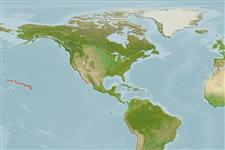>
Ovalentaria/misc (Various families in series Ovalentaria) >
Pomacentridae (Damselfishes) > Chrominae
Etymology: Chromis: Greek, chromis = a fish, perhaps a perch (Ref. 45335).
More on authors: Jordan & Metz.
Environment: milieu / climate zone / depth range / distribution range
Ecologia
marinhas associadas(os) a recifes; não migratória; intervalo de profundidade 6 - 160 m (Ref. 9710), usually 18 - ? m (Ref. 9710). Tropical; 30°N - 15°N
Eastern Central Pacific: Hawaiian and Johnston islands.
Tamanho / Peso / Idade
Maturity: Lm ? range ? - ? cm
Max length : 16.0 cm SL macho/indeterminado; (Ref. 7247)
Descrição suscinta
Chaves de identificação | Morfologia | Morfometria
Espinhos dorsais (total) : 14; Raios dorsais (total) : 12 - 14; Espinhos anais: 2; Raios anais : 12 - 14. Overall color is black. With three pupil-size white spots: one at the rear base of the dorsal fin, one at the rear base of the anal fin, and the third at mid-base of the caudal fin.
Adults form large aggregations high above the bottom in rocky areas around caves and ledges (Ref. 7247). Benthopelagic (Ref. 58302). Collected from 183 m. Spawn from December to June (Ref. 7247). Oviparous, distinct pairing during breeding (Ref. 205). Eggs are demersal and adhere to the substrate (Ref. 205). Males guard and aerate the eggs (Ref. 205).
Ciclo de vida ou comportamento de acasalamento
Maturities | Reprodução | Spawnings | Egg(s) | Fecundities | Larvas
Oviparous, distinct pairing during breeding (Ref. 205). Eggs are demersal and adhere to the substrate (Ref. 205). Males guard and aerate the eggs (Ref. 205).
Allen, G.R., 1991. Damselfishes of the world. Mergus Publishers, Melle, Germany. 271 p. (Ref. 7247)
Status na Lista Vermelha da UICN (Ref. 130435)
Ameaça para os humanos
Harmless
Uso pelos humanos
Pescarias: espécies comerciais; Aquário: Espécies comerciais
Ferramentas
Relatórios especiais
Baixar XML
Fontes da internet
Estimates based on models
Preferred temperature (Ref.
123201): 9.7 - 25.5, mean 20.3 °C (based on 4 cells).
Índice de diversidade filogenética (Ref.
82804): PD
50 = 0.5000 [Uniqueness, from 0.5 = low to 2.0 = high].
Bayesian length-weight: a=0.01778 (0.00796 - 0.03971), b=2.99 (2.81 - 3.17), in cm total length, based on LWR estimates for this Genus-body shape (Ref.
93245).
Nível Trófico (Ref.
69278): 3.3 ±0.0 se; based on diet studies.
Resiliência (Ref.
120179): Elevada, tempo mínimo de duplicação da população menor que 15 meses (Preliminary K or Fecundity.).
Fishing Vulnerability (Ref.
59153): Low vulnerability (12 of 100).
Nutrients (Ref.
124155): Calcium = 95.9 [48.9, 150.3] mg/100g; Iron = 0.922 [0.531, 1.537] mg/100g; Protein = 18.3 [17.1, 19.5] %; Omega3 = 0.136 [0.078, 0.236] g/100g; Selenium = 42.6 [21.8, 85.1] μg/100g; VitaminA = 76.8 [22.4, 267.3] μg/100g; Zinc = 1.29 [0.86, 1.86] mg/100g (wet weight);
